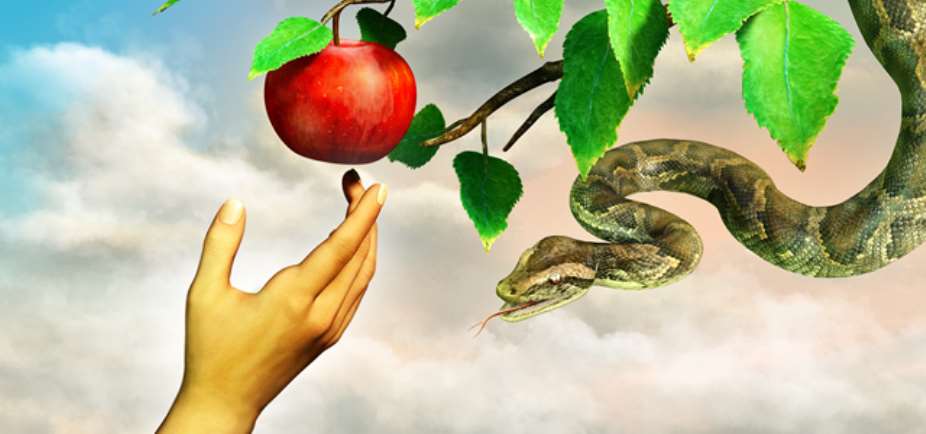Adam and Eve are supposed to be fruitful and multiply in the Garden of Eden by eating from the Tree of Life. But instead of procreating by eating allowed fruit from the Tree of Life while still in the Garden, they eat forbidden fruit, not from an apple tree, but from a forbidden mystery tree named the Tree of Knowledge of Good and Evil, or, as some would call it, the Tree of Knowledge.
But what forbidden fruit do they eat, and how does the eating of this fruit from the wrong tree prevent them from obeying the Genesis 1:28 commandment to be fruitful and multiply by eating from the Tree of Life? Before this question can be answered, the location of the forbidden tree must first be determined. The evidence in the story tells us exactly where that location is within the Garden of Eden.
The Genesis story tells us in Genesis 2:9 and 3:3 both trees are in the center of the allegorical Garden. So the forbidden Tree of Knowledge of Good and Evil is right next to the allowed tree, the Tree of Life, and it's fruit.
If the forbidden fruit from the forbidden tree is literal fruit, the eating of this fruit would give only knowledge of the fruit's taste, not the knowledge of good and evil. But the covering of the genitals with fig leaf aprons following the eating of the "fruit" does indicate sudden acquisition of "knowledge of good and evil," a knowledge that results in sexual shame. It is difficult to understand how eating literal fruit results in sexual shame. And it is difficult to understand how normal and necessary sexual relations between Adam and Eve result in sexual shame, since the only specific commandment to them is to "be fruitful and multiply" in the Garden, a commandment they disobey, because no children are produced until after the eviction from Eden, and after they have normal and necessary sexual relations for the first time in Genesis 4:1.
Adam and Eve execute double disobedience when they eat of the forbidden fruit--they fail to procreate by doing what they are forbidden to do. And they fail to procreate by not doing what they are commanded to do. Both failures occur simultaneously.
The second tree's fruit in the center of the allegorical Garden of Eden, Eve's body, is not forbidden sexual pleasure, but forbidden nonprocreative pleasure derived from a specifically forbidden sexual act, a sexual act that always fails to produce children: Adam and Eve experience pleasurable engagement in nonprocreative anal sex when they yield to the temptation represented in the allegory by the talking snake. They engage in gay same-sex behavior within their opposite-sex marriage.
In partaking of the forbidden pleasure from the forbidden second tree instead of the allowed pleasure from the allowed first tree, Adam and Eve disobey God's first and only commandment to them to be fruitful and multiply in the Garden of Eden.
This long-forgotten exegesis offends our modern sensibilities (for some mysterious reason), but explains everything, and offers not only a superior and more serious exegesis than the eating of a forbidden apple, but also enlightenment for the untrue and oft-repeated "Only God knows what fruit they ate." Yes, a Deity would know what "fruit" they "ate," but the evidence in the Genesis allegory reveals the Deity's knowledge to anyone who wishes to know, and has the courage to overcome emotional resistance and uneasiness resulting from being exposed to this knowledge.
Adam and Eve's own knowledge of good and evil is a byproduct of their disobedient behavior, which is to experience forbidden nonprocreative sexual pleasure by eating allegorical fruit from an allegorical wrong tree in the center of an allegorical garden, while at the same time quite possibly living in a literal garden with literal fruit trees and literal snakes that do not talk to women.





 Akufo-Addo commissions Phase II of Kaleo solar power plant
Akufo-Addo commissions Phase II of Kaleo solar power plant
 NDC panics over Bawumia’s visit to Pope Francis
NDC panics over Bawumia’s visit to Pope Francis
 EC blasts Mahama over “false” claims on recruitment of Returning Officers
EC blasts Mahama over “false” claims on recruitment of Returning Officers
 Lands Minister gives ultimatum to Future Global Resources to revamp Prestea/Bogo...
Lands Minister gives ultimatum to Future Global Resources to revamp Prestea/Bogo...
 Wa Naa appeals to Akufo-Addo to audit state lands in Wa
Wa Naa appeals to Akufo-Addo to audit state lands in Wa
 Prof Opoku-Agyemang misunderstood Bawumia’s ‘driver mate’ analogy – Miracles Abo...
Prof Opoku-Agyemang misunderstood Bawumia’s ‘driver mate’ analogy – Miracles Abo...
 EU confident Ghana will not sign Anti-LGBTQI Bill
EU confident Ghana will not sign Anti-LGBTQI Bill
 Suspend implementation of Planting for Food and Jobs for 2024 - Stakeholders
Suspend implementation of Planting for Food and Jobs for 2024 - Stakeholders
 Tema West Municipal Assembly gets Ghana's First Female Aircraft Marshaller as ne...
Tema West Municipal Assembly gets Ghana's First Female Aircraft Marshaller as ne...
 Dumsor is affecting us double, release timetable – Disability Federation to ECG
Dumsor is affecting us double, release timetable – Disability Federation to ECG
